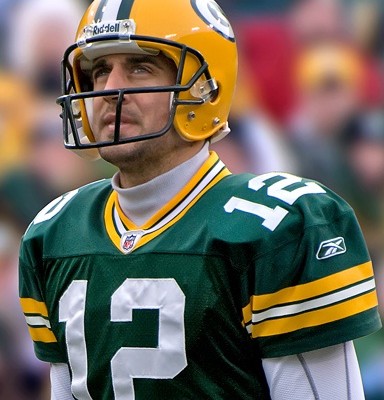Aaron Rodgers Out with Clavical Fracture

Green Bay Packers’ quarterback Aaron Rodgers will be out for at least three weeks with a fractured clavicle. The injury was sustained Monday night, when Rodgers was sacked by Chicago Bears defensive end Shea McClellin. Rodgers landed on his left shoulder and was forced to leave the field. The Packers lost the game 27-20.
There was reportedly too much swelling to thoroughly evaluate the injury last night and further testing today confirmed the diagnosis of a fracture. Fortunately, it doesn’t look like Rodgers will need any surgery to repair the fracture.
Rodgers told ESPN 540:
“I’m in some pain. It’s obviously disappointing what happened last night with the injury and the loss. … Holding out hope this will be a quick heal, but this is a significant injury.”
Rodgers is the latest of several high profile Packer injuries including Pro Bowl linebacker Clay Matthews (thumb), wide receiver Randall Cobb (fibula) and tight end Jermichael Finley (neck).
What is a clavicle fracture?
 The collarbone, also called the clavicle, is considered part of the shoulder, connecting the arm to the body. 80% of clavicle fractures occur in the middle third of the collarbone.
The collarbone, also called the clavicle, is considered part of the shoulder, connecting the arm to the body. 80% of clavicle fractures occur in the middle third of the collarbone.
Although several important blood vessels and nerves lie underneath the clavicle, they are rarely injured when the clavicle is fractured. Common causes of a fractured clavicle include falls onto a shoulder, sports injuries and trauma from traffic accidents. Newborns are also at risk of clavicle fracture while squeezing through the birth canal.
 Symptoms of a clavicle fracture include:
Symptoms of a clavicle fracture include:
- Sagging shoulder (down and forward)
- Inability to lift the arm because of pain
- A grinding sensation if an attempt is made to raise the arm
- A deformity or “bump” over the fracture site
How are clavicle fractures treated?
 Most broken collarbones heal well without surgery. A simple arm sling can usually be used to immobilize the arm. A child may have to wear the sling for 3 to 4 weeks; an adult may have to wear it for 6 to 8 weeks. Depending on the location of the break, a physician may apply a figure-of-eight strap to help maintain shoulder position.
Most broken collarbones heal well without surgery. A simple arm sling can usually be used to immobilize the arm. A child may have to wear the sling for 3 to 4 weeks; an adult may have to wear it for 6 to 8 weeks. Depending on the location of the break, a physician may apply a figure-of-eight strap to help maintain shoulder position.
Analgesics such as acetaminophen (Tylenol) or nonsteroidal anti-inflammatory medications, such as naproxen or ibuprofen (Alleve or Advil/Motrin), will help reduce pain.
For more information, click here to go to the Resounding Health Casebook on clavicle fractures.



























0 comments